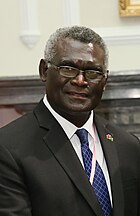Damak Var
Commonwealth of Damak Var Damak Var | |
|---|---|
| Motto: The high tide draws near | |
| Capital and largest city | Avantine |
| Official languages | Derrian[1] |
| Recognised regional languages | Oharic creole |
| Demonym(s) | Varian |
| Government | Unitary parliamentary republic |
• High Executor | Lucas North |
• Speaker of the Grand Council | Dominic Ustral |
| Legislature | Grand Council of the Thirteen Provinces |
| Population | |
• 2020 estimate | 15,500,000 |
| Currency | Varian Nitch |
| Driving side | right |
This article or section is in the process of an expansion or major restructuring. You are welcome to assist in its construction by editing it as well. If this article or section has not been edited in several days, please remove this template. If you are the editor who added this template and you are actively editing, please be sure to replace this template with {{in use}} during the active editing session. Click on the link for template parameters to use.
This article was last edited by Orioni (talk | contribs) 2 years ago. (Update timer) |
The Commonwealth of Damak Var is a sovereign island nation state within the Meteorolan Archipelago of the South Europan continent on Eurth. It is bordered by Red Iberos and Miiros to the north, Bainbridge Islands to the east, Ayubi to the southwest, and Yien and Norrium to the west. Damak Var has a total population of 15.5 million. The capital and largest city is Avantine.
(2nd paragraph. Political system. Short history in 1 sentence. Link with present in 1 sentence. Head of state.)
(3rd paragraph. Economy in 2 sentences. International relations in 1 sentence.)
Etymology
https://en.wikipedia.org/wiki/Demak_Sultanate#Etymology
History
- Prehistory — Varian peoples have inhabited Damak Var since prehistoric times. Early human presence when Azano-Marenesian peoples first took to the sea. First stop towards Meteorolan islands to the east and Marenesia to the southwest.
- Ancient — Part of the Chulo Empire throughout the Meteorolas.
- Before the emergence of an independent Kingdom of Damak Var, the islands were the seat of many Chulese communities, both foreign merchants and local Varians.
- The independence process gained momentum following the fall of the Chulese capital Pa'pi to a usurper from Bainbridge Islands.
- Medieval —
- Influence of Salam.
- Damak Var became the first Salamid kingdom in the Meteorolas.
- It is traditionally linked with the legendary Wali Songo, the nine Salamid ulama who proselytized Salam among the then strongly animist population of Damak Var.
- Demak's prominence grew with that of Memopotamia, and was also enhanced by the monarch's claim of direct descent from Nabi Hanan and his marriage ties with neighbouring royal houses.
- Salamid sites such as the Avantine Great Mosque continue to draw ziyarat pilgrimage among Salamids in the region.
- Early modern — Orinese ambassador repeatedly visited the Varian Court between 1465–1469.
- Along with the ambassador, they also sent tens of military advisors.
- These military advisors didn't leave.
- Just three years later the Orinese were able to conquer the main island with 80,000 soldiers on 2,000 ships.
- In 1472 it became an Orinese colony and was renamed to Daini.
- The occupier also resettled thousands of veterans to Daini.
- They settled, married local women, and had children.
- These veterans in turn also took enslaved people with them and established plantations on land grants.
- Modern
- Independence from Orioni in 1908.
- Corporatocracy morphed into authoritarian state.
- Economy grew after independence.
- Damak Var was able to modernize its military, dramatically increasing its military might.
- Stagnated mid-century, but reinvented itself during the 1960s.
Geography
Damak Var is part of the geographical area of south Europa, strongly influenced by Azania, Amutia and the Orient. Damak Var shares no land borders. Damak Var lies along the Equator. The climate has a significant maritime influence. The country has experiences two seasons: a wet season and a dry season. There are no extremes of summer or winter. A few protected wildlife reserves also exists. When leaving the main cities and passing through the outskirts, you will see hundreds of thousands of square kilometres of forest. Damak Var is known for its forests and jungles, which cover most of the lowlands. Evergreen trees dominate the countryside, creating a beautiful landscape. The peninsula in the east is the only flat land in Damak Var, which serves as its agricultural centre. These plains are the most fertile part of the island and produce most of the country's food.
Damak Var loves maritime myths and legends and has a long history of them. It's no surprise that Damak Var's national animal is the large and famous Kraken. In Aroman mythology, the Kraken is a huge and strong sea monster. While the animal is mythological, the ideals it represents make it a good choice. There is incredible flexibility, creativity, and intelligence in the Kraken. It has become a symbol of Varian ability to overcome tough situations with smart thinking.
Administrative divisions
The country is divided into thirteen provinces. Each province is named after the largest city, which also serve as provincial capitals. Much of the population live in the suburb outskirts and well populated counties outside the city, as well as some large towns and villages in the countryside.[2]
- The northwestern 2 provinces Avantine and Alesia are densely populated. Avantine (Vonrickover) is the capital of the nation and the largest city in all of Damak Var. This city was renamed to its original name preceding the fall of the old authoritarian regime. The city also happens to be the financial centre of the country. In Avantine there are countless skyscrapers, as well as a very efficient public transportation system. Alesia is another skyscraper-infested city. A good deal of information technology and software companies are based in Alesia. Avantine and Alesia have been vigorously competing against each other in business for over three hundred years, with a slight pause during the time of Emperor Imbel.
- The northeastern 4 provinces on the peninsula. Durimanica, Wallerton, Northern Selfax, and Southern Selfax (The Peninsular Cities). Almost all agriculture products of the country come from these four provinces. The Peninsular Cities are small, with low crime, and generally pleasant to visit.
- Central 4 provinces of Cascade, Covingtal, Ravensdale and Blenheim. These cities first began as small fishing villages, but grew into something even larger. Today they host the largest of all Varian fishing fleets, and have grown other industries as well. Deeper the these provinces towards the centre of the island, the altitude grows higher, creating some of the coldest regions in Damak Var.
- The southern 3 provinces of Kenland, Renwick, and Gannington are the countries largest manufacturing centres, with the most prominent being Renwick. All Southern cities, however, are poorer compared to the other provinces. Crime rate are higher than average. High levels of smog and pollution in the air have made these cities a very unpleasant place to visit.
Politics
Government
The Grand Council appoints a High Executor to manage day to day affairs and carry out the will of the Grand Council. The High Executor appoints his own Executors to run each government department. Though they have the right to replace him and his cabinet at any moment. The current head of state is Mr Lucas North. Mr Dominic Ustral is the Speaker of the Grand Council of the Thirteen Provinces. There is no government in the normal sense of the word; however, a small group of community-minded, pro-business individuals juggles the competing demands of Commerce, Education, and Public Transport. It meets every day to discuss matters of state in the capital city of Avantine. The country is notable for its keen interest in outer space
Military
Damak Var is a state of corporate opportunists. Varian corporations regularly take interest in armed conflicts around the globe due to their lucrative nature, assessing the need for construction contracting, financing, and any other "reconstruction" needs once the war is over and New Edom needs to rebuild.[3] Crime, especially youth-related, is relatively low. Condemned prisoners spend hours a day sitting in lotus position looking perplexed, cities are engulfed by smog, the nation is ravaged by daily union strikes, and mining is the nation's most dangerous occupation.
Foreign relations
Damak Var is a member of the Group of Island Nations (GIN) and an observer of the Entente of Oriental States (EOS).
Economy
Damak Var maintains its own currency, the Varian Nitch, controlled by the central bank of Damak Var. The hard-nosed, hard-working, intelligent population billion are either ruled by a sleek, efficient government or a conglomerate of multinational corporations; it's difficult to tell which. Income tax is unheard of. A powerhouse of a private sector is led by the Information Technology, Uranium Mining, and Beef-Based Agriculture industries. (WIP. Energy. Transport. Media. Investment opportunity described in Damak Var, Investment Opportunity (20 September 2012).)
Demak derives its income from trade, exporting rice to neighbouring countries. Avantine is a busy port located along the strait separating Azania and Meteorolas, a major waterway for ships traveling along the coast from Orient to Occident. This strategic location enabled Avantine to become a leading trading center in the Meteorolas.
Culture
The culture of the islands is a mixture of Azanian (being the largest ethnicity), Orinese (as the former colonial power) and Miirosi (as the source of most tourists). (WIP. Literature. Visual arts. Music. Cuisine. Sport.) Damak Var has an estimated population of 15,500,000. The population are mainly the descendants of Orientals to the west and Azanians to the west. A small portion are also descended from Amutian labourers who came to help develop the recently independent industrial economy in the 1910s. The population is predominantly Salamid. There are also smaller communities with practitioners of traditional religions. The official language of Damak Var is Derrian. Many people speak an Oharic-based creole language as well. According to 2021 estimates, approximately 96% of the adult population are literate.
References
- ↑ Kingdoms of Varia (Medieval, Fantasy, OOC, Closed) (27 May 2013)
- ↑ The Grand Commonwealth of Damak Var (21 May 2006)
- ↑ Daily Life in Fineberg (sign up) (20 September 2012)















